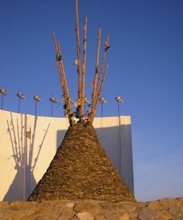|
|
|
|
 |
|
Sacred Texts, Places, Creatures and Sacred Ovoos
The following information has been extracted from the
Mongolian Buddhists Protecting Nature Handbook which can be downloaded in English and in Mongolian.
Sacred Texts
The role of sacred texts, or sutras, in protecting the environment is a very special part of
Mongolian Buddhism - and is an important consideration for anyone wanting to work
on environmental protection with faith bodies. After Buddhism became Mongolia’s
state religion in the 13th century, Mongolian scholars codified and incorporated core
components of ancient pre-Buddhist traditions into the new faith, embracing among
other things the worship of natural sacred sites. So, of the 600 or more venerated
mountains and sacred sites in Mongolia, at least 280 have their own associated
sutras honouring the local environment. More might once have had such references,
but the texts were most likely lost in the purges.
These texts have helped preserve ancient ecological practices over the ages: some
through describing rituals that would protect Mongolia from ecological dangers4;
others through offering prayers to the nature spirits to bring blessings and purify past
misdeeds that disrupt nature; others through inviting Buddhas and deities to clear
obstacles such as natural disasters or incursions of evil; some asking for the increase
of sacred animals such as the snow leopard; and finally some – critically for today’s
ecological initiatives – describing taboos and outlining punishment. For example, in
one area the sutra described how the local goddess would flood a village if the trees
on the mountain were cut down.
“The veneration of mountains is one of the most popular methods of traditional
nature conservation among Mongolians. Mountain-sutras are not only religious
books for ritual ceremonies, but they are also an invaluable repository of
wisdom derived from Mongolian culture.”
Sacred Places
Many mountains, rivers and other natural spaces are revered
as sacred - either because they are the residing place of a
deity or because they are viewed as a deity in themselves.
These natural sites were historically treated with utmost
respect, and protected by taboos. For example, trees should
not be cut within their vicinity nor wild animals hunted. Some
sacred sites are believed to house spirit masters – who often
take a strikingly similar physical form to that of the mountain.
So the spirit master of the bird-shaped Bogd Khaan Mountain
to the south of Ulaanbaatar for example, is in the shape of
a garuda (a huge and powerful mythical bird); to the west
of Ulaanbaatar is a mountain with a spirit master in the
form of an old, blue man. Some of these spirit masters were
thought to be wrathful and therefore liable to punish those
people who broke the taboos while others were thought
to be benevolent, protecting people from natural disasters
for example, and therefore deserving to be thanked. Some
deities are female.
Sacred Birds and Animals
Sometimes mountains were named after animals. The
ecological significance of this is still important: there is
frequently a specific taboo on the hunting or trapping of
this animal on the sites, and where these taboos are not
apparent today, any ecological initiative can benefit from
reminding the local people of the ancient beliefs, through
working with the local clergy. Besides their association with
certain natural sites, some animals were considered sacred
in their own right.
 |
 |
 |
Ovoos are piles of stones that traditionally indicate sacred sites. Photo courtesy of the Tributary Fund. |
The wolf and deer are the most obvious
examples, while snakes and fish were considered animals of
the nagas, or nature spirits. The hunting, harming, trapping
or eating of any of these animals - as well as antelope,
argali sheep, mountain goats, migratory birds and other rare
species - was considered sinful.
There are also ancient beliefs that casting one’s shadow on,
or touching, the nest or eggs of any bird is taboo, and that
killing certain birds would enrage the heavens. As a result
of these beliefs, some internationally endangered birds live
comparatively unharmed in Mongolia, although this situation
has begun to change.
Ovoo Worship
Even if you are not Mongolian, you can usually recognise a sacred Mongolian
mountain. It is generally an impressive, high feature on the landscape, often with an
unusual shape and supporting an abundance of wildlife and fresh-water sources.
And, because it has been worshipped for centuries, it almost certainly has an “ovoo”
at its summit.
Ovoos are piles of stones that traditionally indicate sacred sites. They
can be found on the top of mountains or hills, at water sources and on the edge
of rivers and lakes that have a sacred significance. When passing an ovoo, people
traditionally circumambulate it three times while saying a prayer that translates as:
“Greatness of ovoos to you; Greatness of gains to me; Greatness of glory to you;
Greatness of spirit to me; Greatness of height to you; greatness of good fortune to
me.” They then leave small offerings to bless their journey and the pleased spirits
are believed to provide land fertility, good weather, health, and prevent disasters
in return. They are particularly believed to be critical in helping the regeneration of
land that has been developed by humans.
Ovoo worship is a very common activity
in Mongolia and most laypeople as well as monks know the practices well.
Many monasteries view ovoo worship to be one of their central responsibilities -
from both a religious and (increasingly) an environmental perspective. For example,
Gandan and Dashchoilin - environmentally active monasteries - are responsible for
the worship of ovoos all over Mongolia and in particular the five main government
ovoos: Otgon Tenger, Burkhan Khaldun, Altan Khokhii, Tsetsee Gun (Bogd Khaan)
and Altan Ovoo. According to Dashchoilin monk N. Batsaikhan, worshipping these
five main government mountains and their ovoos is the most important work in
Mongolia. “People go along with the monks to worship the mountains. According to
tradition, even the President and Minister must attend”.
Mongolian Buddhists Protecting Nature.
Pages about Mongolian Environmental Wisdom, taken from the Handbook.
The Mongolian Lord of Nature.
Sacred texts, places and ovoos.
Sacred sites
in Mongolia.
Traditional Environmental Law in Mongolia.
The work that the monks, in conjunction with ARC and the World Bank and others, are carrying out to rediscover the sutras about sacred land in Mongolia.
Do you want to support this?
For full contact and address details of Mongolian Buddhist Monasteries, please see page 57 of the
Handbook. And for details of local Development, Environmental and Educational NGOs, please visit pages 58-59 of the
Handbook.
Other links to Mongolian Buddhism and the Environment
Link here to access the news story about the launch of the Mongolian Buddhist Handbook.
Link
here to download the Mongolian Buddhist Handbook in English. (Please note this file is 1.15MB)
Link
here to download the Mongolian version of the Handbook.(A 2MB file.)
Link here to download the guide to the Mongolian Buddhists’ Eight Year Plan (this file is 4.13MB).
Link to Mongolian Case Studies.
And
here on how to make contact with the Sangha.
To download the A3 poster of a new thangka about Buddhists protecting Nature, link
here (5.61MB).
Brief History of Mongolian Buddhism.
Buddhism and the Environment.
Women in Buddhism in Mongolia.
Key Figures in Mongolian Buddhism.
Key Meetings in Mongolia.
Mongolian Buddhists and Development.
Mongolian Buddhists and Ecology.
Mongolian Buddhist Hunting Ban.
The Lost Sutras.
|
 |
|
|
|
|
|
 |
Buddhist Faith Statement
A formal statement of Buddhist beliefs about creation and ecology: "The trees are like our mother and father, they feed us, nourish us, and provide us with everything" |
 |
Sacred Mongolian Environmental Texts
The key to Mongolia's sacred landscapes lay hidden in ancient Buddhist texts |
 |
Last updated: September 24, 2009 :
Latest news on the Long Term Commitments
A sample of some of the faith groups around the world that are creating Five, Seven, Eight and Nine Year Plans to protect the natural environment, through the UNDP-ARC framework. |
 |
 |
|
|

